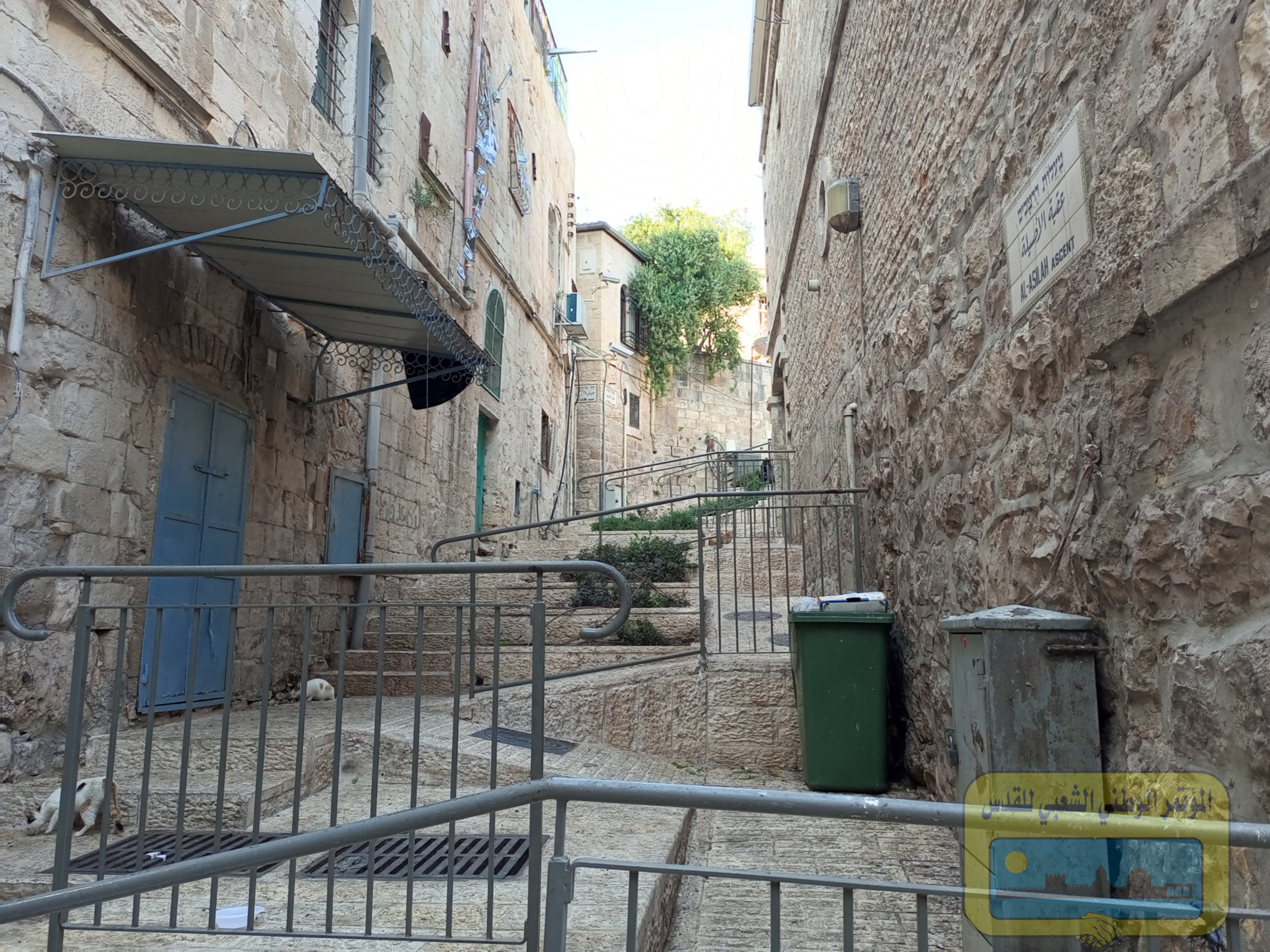Street Stairways
The lanes of Old Jerusalem and its streets are full of stairs (obstacles), many of which were created during the Ayyubid period, and their names were attributed to people or families who lived there or places that contained them, and these obstacles that combine antiquity and beauty are the arteries connecting the lanes of the holy city and its markets.
These obstacles, like other components of the Old City in Jerusalem, are being subjected to a fierce attack aimed at Judaizing their names and controlling their holy and historical places, houses and shops, by Israeli government decisions, municipal measures, settlement association plans, and destructive excavations that have not found any grounds for the occupation to prove its historical or religious narrative.
The following are the most important obstacles as documented by the Palestinian National Information Center:
Uqba Al-Tuta: located inside the walls of the Old Town; It is a small road connecting the wad road (one of the important arteries of the Old Town) to the Khan Al-Zeit road.
.jpg)
Sheikh Lulu's obstacle: it is located southeast of Bab al-Amud, adjacent to the Old Town wall, to the left of the interior heading to Sheikh Lulu mosque and Saadia lane. It was named after Prince Badr al-Din Lu'lu, one of the princes of the era of Saladin.
.jpg)
Sheikh Rayhan Aqaba: located in Saadia lane, inside the walls of the Old Town, specifically in Saadia Lane in the Islamic quarter, it was named after the Sheikh Rayhan mosque located in it.
.jpg)
Uqba al-Saraya: it is located in the Islamic quarter inside the old walls of the country, which is the road extending from Uqba Al-Khalidiya, towards Al-qarmi road, and the Islamic orphans Industrial School is located there.
.jpg)
The original obstacle: it extends from the Valley Road towards the Red Crescent Road, and is behind the Austrian Inn on the left of the Valley Road when climbing towards the East.

Uqba Shaddad: it is located in the Saadia Lane in the Islamic quarter inside the walls of the Old Town, and it is one of the connecting roads between Uqba Darwish and the red Minaret Road, from which we reach Sheikh Hassan's Uqba, then to the Mujahideen road to Al-Aqsa Mosque.
Uqba Al-bataykh: it is located in the middle of Khan Al-Zeit Market, opposite Uqba Al-Tuta, going up towards Al-Nasari lane; it is a road connecting Khan Al-Zeit with Al-Nasari lane; and the junction of this road, between Khan Al-Zeit and Al-bataykh, is one of the links connecting the Muslim neighborhood with the Christian.
.jpg)
Mawlaviyya Aqaba: it is a road that extends from the red Minaret Road, towards Bab al-Amud, passing through Sheikh Rayhan's Aqaba; there is a Maqam and the mawlaviyya Zawiya mosque in it.
.jpg)
Uqba Al-Bastami: located in Al-saadiyya lane, inside the walls of the Old Town, in the Islamic quarter; it stretches between Al-qadisiyya road and Al-Hamra Minaret Road.
Aqaba Boumediene: located at the gate of the chain; it was named after this name after "my father, the relief debtor," who stopped it on the poor and needy members of the Maghrebi community in the city of Jerusalem in 720 Hijri (1320 AD).
Nuns 'obstacle (island) nuns' obstacle (island)
The nuns ' obstacle (stair of the Holy One): a winding road connects Al-ghawanmeh lane with Al-Saadia Lane, which is the road extending from the path of suffering towards the North, and on the right of the road is the ADAS monastery for the Greek Orthodox, and on the left of it is the monastery of the Sisters of Zion of Al-ghawanmeh lane.
Aqaba Dar Al-bayraq: it is a narrow road that stretches from Bab al-ghawanmeh towards Al-Wad Street, and there is an Afghan corner in it.
The National Guard obstacle: it is the road connecting barquq road and Alam Road towards the North, bordered on the right by the Naqshbandi and Afghan corners.
Aqaba Al-Hakkari (the brick staircase): located at the end of Aqaba Al-Khalidiya, the chain door Road connects to the honor Lane. It is said to be attributed to a Sufi man who used to live in the neighborhood, whose family name is Al-Hakkari.
The Khanqah obstacle is located in the Christian Quarter and represents the eighth stage of the path of passion, at the monastery known as the"Khar Al-ambos monastery for the Greek Orthodox".
.jpg)
Aqaba Al-Khalidiya: it is the road extending from Al-Wad Road, opposite Al-qattaneen market, and extending west towards Al-qarmi road. Settlers took over some of her houses and also erected a synagogue.
A March for settlers in Aqaba Khalidiya in the Old City of Occupied Jerusalem (Al Jazeera)
Aqaba Darwish: Aqaba Darwish is located inside the walls of the Old City in the Saadia lane of the Islamic quarter, which is the road extending from Mujahideen road towards Bab Al-Sahra, until Qadisiya road.
Pomegranate love obstacle: pomegranate love obstacle is located in Saadia Lane in the Islamic quarter within the walls of the Old Town
Mufti's obstacle (the path of pain): it is located inside the walls of the Old Town and connects the wad road to the Khan Al-Zeit market. It bore the name "Mufti's obstacle" after the mufti of Palestine (Haj Amin al-Husseini), as his house is located to the left of this road, and it was called the path of pain, because it is located in the path of pain.
Aqaba Al-tikya or "Aqaba Al-set": located inside the walls of the Old Town, it connects wad road and The Last Khan Al-Zeit market. It was named "hospice" after the Hospice of khaski Sultan.
.jpg)
.jpg)
Aqaba Al-jabsha: it is located to the right of the interior of the column door towards the west towards the Christian Lane.
